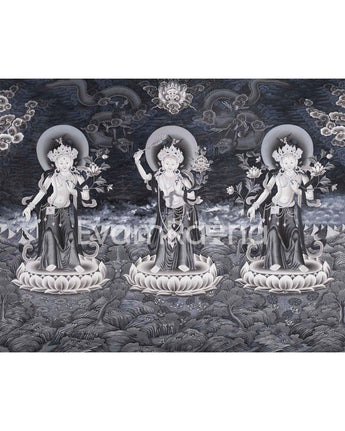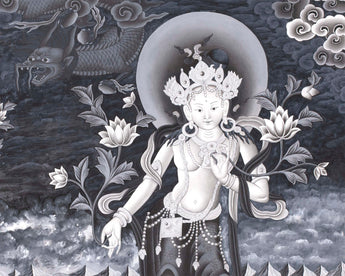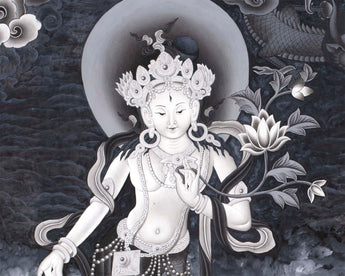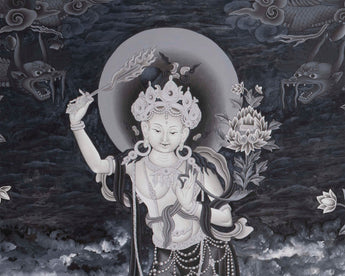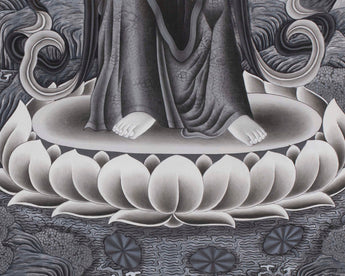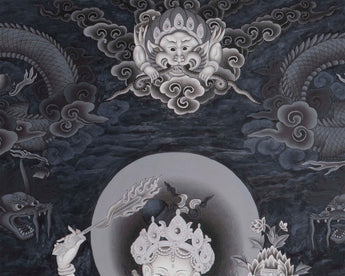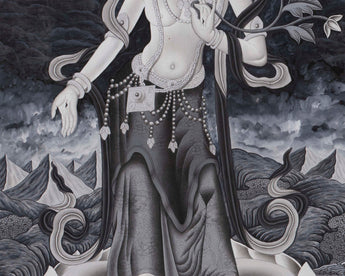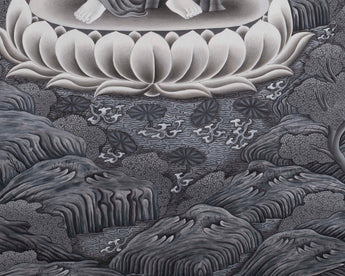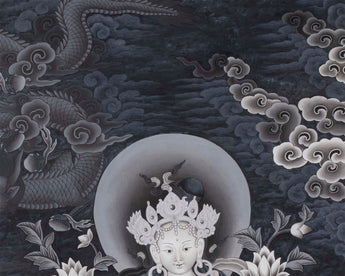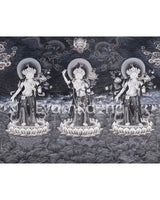
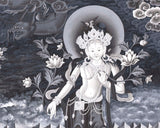
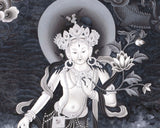
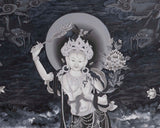

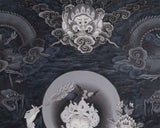
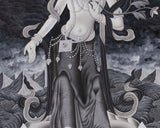
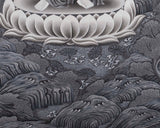

Newari Thangka | White Tara, Manjushri and Green Tara Standing

100% AUTHENTIC

HANDPAINTED

FREE SHIPPING
Newari Thangka
Original Size of Thangka ( 39 x 49 Inches )
About Thangka
The painting displayed in this picture is a beautiful Newari-style thangka painting with iconographies of Green Tara, Manjushree, and White Tara; Three different bodhisattvas. Here, all of the bodhisattvas are arranged in a standing position and are depicted looking down at the samsara with great compassion.
Green Tara
On the Right side of this monochromatic painting, we see Green Tara, a female Buddhist deity linked to enlightened activity and abundance. She is widely regarded as a compassionate and action-oriented Bodhisattva. She is swift to take action, whenever someone asks for help. Therefore, She is an inexhaustible source of compassion.revered as a protector who comes to alleviate physical, mental, and spiritual suffering.
Green Tara is said to have been born from Avalokiteshvara's compassionate tear as he gazed down on the realm of suffering.
This thangka painting shows her with an aura and energy of a compassionate 16 years old Maiden. Likewise, she is portrayed over a lotus in a standing position.
Bodhisattva Manjushree
Then in between White Tara and Green Tara, we have the figure of Bodhisattva Manjushree who is regarded as the “lord of Divine Wisdom”. His worship confers mastery of the dharma, retentive memory, mental perfection, and eloquence.
In Mahayana Buddhist Tradition, he is regarded as having supreme wisdom among all Bodhisattvas. He is also called the prince of the Dharma because of his eloquent wisdom.
He carries the sword of wisdom of emptiness for destroying ignorance with his right hand .His left hand holds a lotus flower over which a Manuscript is placed. This Book of transcendental wisdom is the mother of all the enlightened ones. It is believed that worshipping Manjushree can confer upon wisdom, memory and intelligence.
White Tara
Finally, on the left side of this beautiful Newari-style thangka painting, we see mother White Tara. She is one of the most important deities in Buddhism often worshipped for long life, along with sound physical and mental health. Manifestation of living compassion, White Tara is depicted as radiant as the moon, symbolizing purity. It is believed that revering White Tara blesses us with long life which we can use to earn merits to free us from the cycle of suffering, rebirth, old age, and death.
Likewise, she also inspires us to benefit other beings with the blessings we receive. Loving Mother White Tara is also the witness to all grief and responds to every call for help. The practice of White Tara is performed to attain prolonged life as well as for healing purposes.
Here, White Tara is on a lotus throne, Her left hand, which is placed on her heart, holds the stem of a blossoming lotus beside her left shoulder. Similarly, her right hand is in Varadamudra, symbolizing supreme generosity.
She is wearing all six ornaments and looks like a beautiful sixteen-year-old maiden. She has seven eyes, two in the palms of her hand, two in the soles of her feet, and one in her forehead.
This painting is perfect for your Shrine or your Hall.
White Tara, Manjushri Traditional Hand-Painted Newari Thangka:
Manjushri also known as jampelyang is the embodiment of wisdom of buddhas of three times. He is holding blazing sword in right hand symbolizing cutting the darkness of ignorance. left hand is holding lotus flower with holy text book symbolizing wisdom or teaching of buddha. Mañjuśrī is depicted as a male bodhisattva. buddhists believe that the worship of Manjushri can confer upon them wisdom, a retentive memory, intelligence and eloquence, and enables them to master many sacred scriptures. Not only that people are praying manjushri to get the power to learn anything mundane, like music, art, to learn languages, and so forth. so in the past as well as at present among buddhists families they let recite the prayer of manjushri to their young kids so that they could learn anything mundane and ultimate teachings at ease.
Tārā is a meditation deity worshiped by practitioners of the Tibetan branch of Vajrayana Buddhism to develop certain inner qualities and to understand outer, inner and secret teachings such as karuṇā (compassion), mettā (loving-kindness), and shunyata (emptiness). Tārā may more properly be understood as different aspects of the same quality, as bodhisattvas are often considered metaphors for Buddhist virtues.
------------------------------------------------------------------
Size: 40"/ 101 cm (width) x 50"/ 127 cm (height)
Materials: Cotton Canvas, Acrylic Colors, Genuine 24K Gold
------------------------------------------------------------------
THIS THANGKA IS HAND-PAINTED IN THE TRADITIONAL STYLE BY NEPALI ARTIST AND THE QUALITY IS HIGH
What does White Tara mantra “MAMA AYUR PUNE GYANA PUNTIN KURU SOHA” define?
- Mama = mine, means that I would like to possess the following qualities.
- Ayurur = long life
- Punene = merit that comes from living life ethically.
- Gyana = wisdom
- Puntin = increase
- Kuru = do so! do it now!
- Soha= hail, or may blessings be upon


